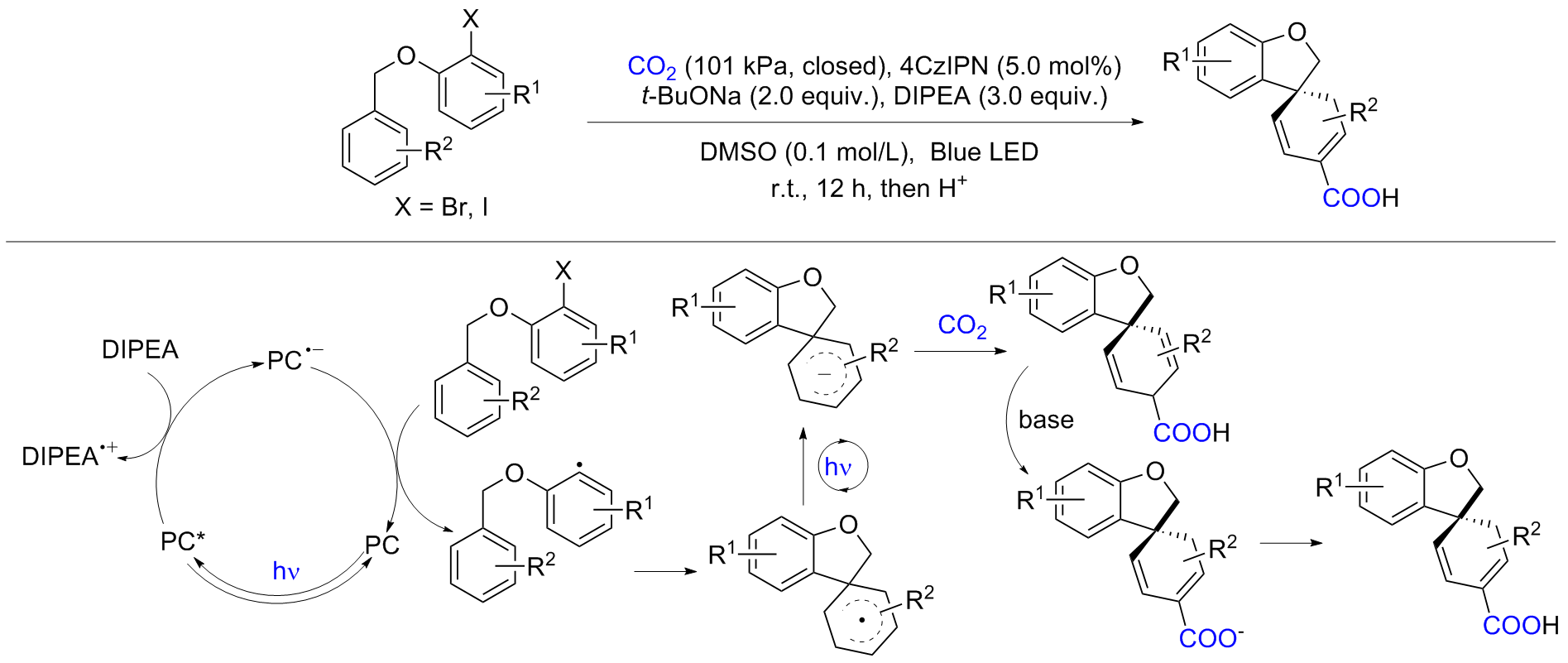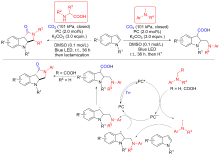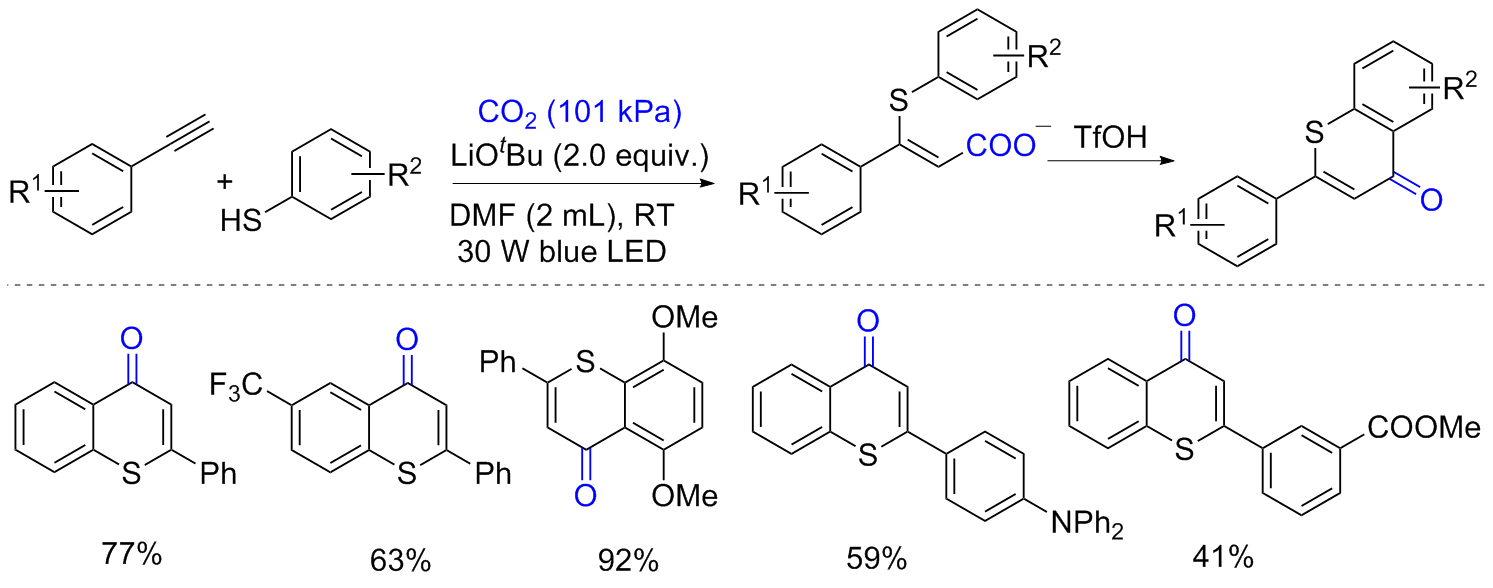有机化学 ›› 2024, Vol. 44 ›› Issue (10): 2961-2996.DOI: 10.6023/cjoc202405041 上一篇 下一篇
综述与进展
李文珂a,†, 孙北奇b,†, 张雷a,*( ), 莫凡洋a,c,*(
), 莫凡洋a,c,*( )
)
收稿日期:2024-09-05
修回日期:2024-09-21
发布日期:2024-10-11
作者简介:†共同第一作者
基金资助:
Wenke Lia,†, Beiqi Sunb,†, Lei Zhanga,*( ), Fanyang Moa,c,*(
), Fanyang Moa,c,*( )
)
Received:2024-09-05
Revised:2024-09-21
Published:2024-10-11
Contact:
*E-mail: About author:†These authors contributed equally to this work
Supported by:文章分享

二氧化碳(CO2)是一种对气候变化有重要影响的温室气体. 从化学角度考虑, 作为“碳一(C1)”资源, CO2具有储量丰富、廉价易得及无毒可再生等特点. 通过化学转化的方式将CO2资源化利用, 并用于合成高附加值化学品, 是服务国家重大战略需求的重要方式, 也是响应国家2030年“碳达峰”与2060年“碳中和”目标的重要举措. 有机光催化能够利用光能激发电子转移, 引发化学键的断裂和重组, 促进反应的进行, 具备条件温和、绿色清洁以及选择性高等优点. CO2资源化利用与有机光催化相结合所形成的光催化羧基化反应体系, 能够为羧基化反应的研究提供新思路. 系统阐述了两种光催化羧基化反应, 即以碳负离子为关键中间体和以CO2自由基负离子为关键中间体的羧基化反应.
李文珂, 孙北奇, 张雷, 莫凡洋. 基于自由基机理光催化羧基化反应研究进展[J]. 有机化学, 2024, 44(10): 2961-2996.
Wenke Li, Beiqi Sun, Lei Zhang, Fanyang Mo. Recent Advances in Photocatalytic Carboxylation Based on Free Radical Process[J]. Chinese Journal of Organic Chemistry, 2024, 44(10): 2961-2996.






| [1] |
Aresta, M.; Dibenedetto, A. Dalton Trans. 2007, 2975.
|
| [2] |
Lu, P.-F.; Ruan, S.-J. China Resour. Compr. Util. 2024, 42, 100. (in Chinese)
|
|
(鲁佩芳, 阮少军, 中国资源综合利用, 2024, 42, 100.)
|
|
| [3] |
Fan, Z.; Zhang, Z.; Xi, C. ChemSusChem 2020, 13, 6201.
|
| [4] |
(a) Heacock, R.; Kašpárek, S. Adv. Heterocycl. Chem. 1969, 10, 43.
|
|
(b) Maruyama, K.; Katagiri, T. J. Phys. Org. Chem. 1989, 2, 205.
|
|
|
(c) Millar, I. T.; Heaney, H. Chem. Soc. 1957, 11, 109.
|
|
|
(d) Rieke, R. D.; Hanson, M. V. Tetrahedron 1997, 53, 1925.
|
|
| [5] |
(a) Behr, A. Chem. Eng. Technol. 1987, 10, 16.
pmid: 21387036 |
|
(b) Huang, K.; Sun, C.-L.; Shi, Z.-J. Chem. Soc. Rev. 2011, 40, 2435.
doi: 10.1039/c0cs00129e pmid: 21387036 |
|
|
(c) Riduan, S. N.; Zhang, Y. Dalton Trans. 2010, 39, 3347.
pmid: 21387036 |
|
|
(d) Tsuji, Y.; Fujihara, T. Chem. Commun. 2012, 48, 9956.
pmid: 21387036 |
|
| [6] |
(a) Bontemps, S. Coord. Chem. Rev. 2016, 308, 117.
pmid: 27070820 |
|
(b) Liu, G.; Meng, X.; Zhang, H. Angew. Chem., Int. Ed. 2017, 56, 5570.
pmid: 27070820 |
|
|
(c) Ravelli, D.; Protti, S.; Fagnoni, M. Chem. Rev. 2016, 116, 9850.
doi: 10.1021/acs.chemrev.5b00662 pmid: 27070820 |
|
|
(d) Smith, K. Chem. Soc. Rev. 1974, 3, 443.
pmid: 27070820 |
|
| [7] |
(a) Appel, A. M.; Bercaw, J. E.; Bocarsly, A. B.; Dobbek, H. Chem. Rev. 2013, 113, 6621.
pmid: 38179949 |
|
(b) Kathiraser, Y.; Oemar, U.; Saw, E. T.; Li, Z.; Kawi, S. Chem. Eng. J. 2015, 278, 62.
pmid: 38179949 |
|
|
(c) MacDowell, N.; Florin, N.; Buchard, A.; Hallett, J. Energy Environ. Sci. 2010, 3, 1645.
pmid: 38179949 |
|
|
(d) Saha, P.; Amanullah, S.; Dey, A. Acc. Chem. Res. 2022, 55, 134.
pmid: 38179949 |
|
|
(e) Yin, X.; Moss, J. R. Coord. Chem. Rev. 1999, 181, 27.
pmid: 38179949 |
|
|
(f) Yu, D.; Teong, S. P.; Zhang, Y. Coord. Chem. Rev. 2015, 293, 279.
pmid: 38179949 |
|
|
(g) Zhang, B.; Li, T.-T.; Mao, Z.-C.; Jiang, M.; Zhang, Z.; Zhao, K.; Qu, W.-Y.; Xiao, W.-J.; Chen, J.-R. J. Am. Chem. Soc. 2024, 146, 1410.
doi: 10.1021/jacs.3c10439 pmid: 38179949 |
|
|
(h) Du, C.-Y.; Chen, Y.-F. Acta Chim. Sinica 2020, 78, 938. (in Chinese)
pmid: 38179949 |
|
|
(杜重阳, 陈耀峰, 化学学报, 2020, 78, 938.)
doi: 10.6023/A20060268 pmid: 38179949 |
|
| [8] |
(a) Ashley, A. E.; Thompson, A. L.; O'Hare, D. Angew. Chem., Int. Ed. 2009, 48, 9839.
|
|
(b) Mömming, C. M.; Otten, E.; Kehr, G.; Fröhlich, R.; Grimme, S.; Stephan, D. W.; Erker, G. Angew. Chem., Int. Ed. 2009, 48, 6643.
|
|
|
(c) Stephan, D. W. Acc. Chem. Res. 2015, 48, 306.
|
|
|
(d) Stephan, D. W. J. Am. Chem. Soc. 2015, 137, 10018.
|
|
|
(e) Stephan, D. W.; Erker, G. Angew. Chem., Int. Ed. 2010, 49, 46.
|
|
| [9] |
(a) Glueck, S. M.; Gümüs, S.; Fabian, W. M.; Faber, K. Chem. Soc. Rev. 2010, 39, 313.
pmid: 27856910 |
|
(b) Shi, J.; Jiang, Y.; Jiang, Z.; Wang, X. Chem. Soc. Rev. 2015, 44, 5981.
pmid: 27856910 |
|
|
(c) Schwander, T.; Schada von Borzyskowski, L.; Burgener, S.; Cortina, N. S. Science 2016, 354, 900.
pmid: 27856910 |
|
|
(d) Zheng, Y.; Zhang, W.; Li, Y.; Chen, J.; Yu, B.; Wang, J.; Zhang, L.; Zhang, J. Nano Energy 2017, 40, 512.
pmid: 27856910 |
|
| [10] |
(a) Benson, E. E.; Kubiak, C. P.; Sathrum, A. J.; Smieja, J. Chem. Soc. Rev. 2009, 38, 89.
doi: 10.1039/b804323j pmid: 24935751 |
|
(b) Goeppert, A.; Czaun, M.; Jones, J.-P.; Prakash, G. S.; Olah, G. A. Chem. Soc. Rev. 2014, 43, 7995.
doi: 10.1039/c4cs00122b pmid: 24935751 |
|
| [11] |
(a) Sun, J.; Fujita, S.-I.; Arai, M. J. Organomet. Chem. 2005, 690, 3490.
|
|
(b) Jutz, F.; Andanson, J.-M.; Baiker, A. Chem. Rev. 2011, 111, 322.
|
|
|
(c) Zhang, X.; Zhang, X.; Dong, H.; Zhao, Z.; Zhang, S.; Huang, Y. Energy Environ. Sci. 2012, 5, 6668.
|
|
|
(d) Ye, J.-H.; Ju, T.; Huang, H.; Liao, L.-L.; Yu, D.-G. Acc. Chem. Res. 2021, 54, 2518.
|
|
| [12] |
Yatham, V. R.; Shen, Y.; Martin, R. Angew. Chem., Int. Ed. 2017, 56, 10915.
|
| [13] |
Hou, J.; Ee, A.; Cao, H.; Ong, H. W.; Xu, J. H.; Wu, J. Angew. Chem., Int. Ed. 2018, 57, 17220.
|
| [14] |
Fu, Q.; Bo, Z.-Y.; Ye, J.-H.; Ju, T.; Huang, H.; Liao, L.-L.; Yu, D.-G. Nat. Commun. 2019, 10, 3592.
|
| [15] |
Wang, H.; Gao, Y.; Zhou, C.; Li, G. J. Am. Chem. Soc. 2020, 142, 8122.
doi: 10.1021/jacs.0c03144 pmid: 32309942 |
| [16] |
Zhang, B.; Yi, Y.; Wu, Z.-Q.; Chen, C.; Xi, C. Green Chem. 2020, 22, 5961.
|
| [17] |
Liao, L.-L.; Cao, G.-M.; Jiang, Y.-X.; Jin, X.-H.; Hu, X.-L.; Chruma, J. J.; Sun, G.-Q.; Gui, Y.-Y.; Yu, D.-G. J. Am. Chem. Soc. 2021, 143, 2812.
doi: 10.1021/jacs.0c11896 pmid: 33561344 |
| [18] |
Bai, J.; Li, M.; Zhou, C.; Sha, Y.; Cheng, J.; Sun, J.; Sun, S. Org. Lett. 2021, 23, 9654.
|
| [19] |
Niu, Y.-N.; Jin, X.-H.; Liao, L.-L.; Huang, H.; Yu, B.; Yu, Y.-M.; Yu, D.-G. Sci. China: Chem. 2021, 64, 1164.
|
| [20] |
Zhang, M.; Yang, L.; Zhou, C.; Fu, L.; Li, G. Asian J. Org. Chem. 2022, 11, e202200087.
|
| [21] |
Li, W.; Sun, B.; Zhang, L.; Mo, F. Green Chem. 2023, 25, 5030.
|
| [22] |
Yuan, P. F.; Yang, Z.; Zhang, S. S.; Zhu, C. M.; Yang, X. L.; Meng, Q. Y. Angew. Chem., Int. Ed. 2024, 136, e202313030.
|
| [23] |
Cao, K.-G.; Gao, T.-Y.; Liao, L.-L.; Ran, C.-K.; Jiang, Y.-X.; Zhang, W.; Zhou, Q.; Ye, J.-H.; Lan, Y.; Yu, D.-G. Chin. J. Catal. 2024, 56, 74.
|
| [24] |
Zhou, C.; Wang, X.; Yang, L.; Fu, L.; Li, G. Green Chem. 2022, 24, 6100.
|
| [25] |
Meng, Q.-Y.; Schirmer, T. E.; Berger, A. L.; Donabauer, K.; König, B. J. Am. Chem. Soc. 2019, 141, 11393.
|
| [26] |
Song, L.; Fu, D. M.; Chen, L.; Jiang, Y. X.; Ye, J. H.; Zhu, L.; Lan, Y.; Fu, Q.; Yu, D. G. Angew. Chem., Int. Ed. 2020, 59, 21121.
|
| [27] |
Liu, Y.; Wang, Z.-H.; Xue, G.-H.; Chen, L.; Yuan, L.-H.; Li, Y.-W.; Yu, D.-G.; Ye, J.-H. Chin. Chem. Lett. 2024, 35, 109138.
|
| [28] |
Li, W.; Sun, B.; Zhang, L.; Mo, F. J. Org. Chem. 2023, 89, 521.
|
| [29] |
Ju, T.; Fu, Q.; Ye, J. H.; Zhang, Z.; Liao, L. L.; Yan, S. S.; Tian, X. Y.; Luo, S. P.; Li, J.; Yu, D. G. Angew. Chem., Int. Ed. 2018, 57, 13897.
|
| [30] |
Fan, X.; Gong, X.; Ma, M.; Wang, R.; Walsh, P. Nat. Commun. 2018, 9, 4936.
|
| [31] |
Jiang, Y. X.; Chen, L.; Ran, C. K.; Song, L.; Zhang, W.; Liao, L. L.; Yu, D. G. ChemSusChem 2020, 13, 6312.
|
| [32] |
Liao, L.-L.; Cao, G.-M.; Ye, J.-H.; Sun, G.-Q.; Zhou, W.-J.; Gui, Y.-Y.; Yan, S.-S.; Shen, G.; Yu, D.-G. J. Am. Chem. Soc. 2018, 140, 17338.
doi: 10.1021/jacs.8b08792 pmid: 30518213 |
| [33] |
Chen, L.; Qu, Q.; Ran, C. K.; Wang, W.; Zhang, W.; He, Y.; Liao, L. L.; Ye, J. H.; Yu, D. G. Angew. Chem., Int. Ed. 2023, 62, e202217918.
|
| [34] |
(a) Correa, A.; Martin, R. J. Am. Chem. Soc. 2009, 131, 15974.
|
|
(b) Fujihara, T.; Nogi, K.; Xu, T.; Terao, J.; Tsuji, Y. J. Am. Chem. Soc. 2012, 134, 9106.
|
|
|
(c) Leon, T.; Correa, A.; Martin, R. J. Am. Chem. Soc. 2013, 135, 1221.
|
|
| [35] |
Jing, K.; Wei, M.-K.; Yan, S.-S.; Liao, L.-L.; Niu, Y.-N.; Luo, S.-P.; Yu, B.; Yu, D.-G. Chin. J. Catal. 2022, 43, 1667.
doi: 10.1016/S1872-2067(21)63859-7 |
| [36] |
Hang, W.; Li, D.; Zou, S.; Xi, C. J. Org. Chem. 2023, 88, 5007.
|
| [37] |
Fan, Z.; Yi, Y.; Xi, C. Tetrahedron Green Chem. 2023, 2, 100028.
|
| [38] |
Yan, S.-S.; Liu, S.-H.; Chen, L.; Bo, Z.-Y.; Jing, K.; Gao, T.-Y.; Yu, B.; Lan, Y.; Luo, S.-P.; Yu, D.-G. Chem 2021, 7, 3099.
|
| [39] |
Bo, Z.-Y.; Yan, S.-S.; Gao, T.-Y.; Song, L.; Ran, C.-K.; He, Y.; Zhang, W.; Cao, G.-M.; Yu, D.-G. Chin. J. Catal. 2022, 43, 2388;
|
| [40] |
Fan, Z.; Yi, Y.; Chen, S.; Xi, C. Org. Lett. 2021, 23, 2303.
|
| [41] |
Cao, G.-M.; Hu, X.-L.; Liao, L.-L.; Yan, S.-S.; Song, L.; Chruma, J. J.; Gong, L.; Yu, D.-G. Nat. Commun. 2021, 12, 3306.
|
| [42] |
Okumura, S.; Uozumi, Y. Org. Lett. 2021, 23, 7194.
|
| [43] |
Ran, C.-K.; Niu, Y.-N.; Song, L.; Wei, M.-K.; Cao, Y.-F.; Luo, S.-P.; Yu, Y.-M.; Liao, L.-L.; Yu, D.-G. ACS Catal. 2021, 12, 18.
|
| [44] |
Li, W.-D.; Wu, Y.; Li, S.-J.; Jiang, Y.-Q.; Li, Y.-L.; Lan, Y.; Xia, J.-B. J. Am. Chem. Soc. 2022, 144, 8551.
|
| [45] |
Gao, T.-Y.; Mo, X.-Y.; Zhang, S.-R.; Jiang, Y.-X.; Luo, S.-P.; Ye, J.-H.; Yu, D.-G. Chin. Chem. Lett. 2024, 35, 109364.
|
| [46] |
Zhou, W.-J.; Wang, Z.-H.; Liao, L.-L.; Jiang, Y.-X.; Cao, K.-G.; Ju, T.; Li, Y.; Cao, G.-M.; Yu, D.-G. Nat. Commun. 2020, 11, 3263
|
| [47] |
Gao, Y.; Wang, H.; Chi, Z.; Yang, L.; Zhou, C.; Li, G. CCS Chem. 2022, 4, 1565.
|
| [48] |
Yi, Y.; Xi, C. Chin. J. Catal. 2022, 43, 1652.
|
| [49] |
Yi, Y.; Fan, Z.; Xi, C. Green Chem. 2022, 24, 7894.
|
| [50] |
Gao, W.; Yang, Q.; Yang, H.; Yao, Y.; Bai, J.; Sun, J.; Sun, S. Org. Lett. 2024, 26, 467.
|
| [51] |
(a) Hendy, C. M.; Smith, G. C.; Xu, Z.; Lian, T.; Jui, N. T. J. Am. Chem. Soc. 2021, 143, 8987.
|
|
(b) Gui, Y.-Y.; Yan, S.-S.; Wang, W.; Chen, L.; Zhang, W.; Ye, J.-H.; Yu, D.-G. Chin. Sci. Bull. 2023, 68, 3124.
|
|
|
(c) Majhi, J.; Molander, G. Angew. Chem., Int. Ed. 2024, 136, e202311853.
|
|
| [52] |
Seo, H.; Liu, A.; Jamison, T. F. J. Am. Chem. Soc. 2017, 139, 13969.
|
| [53] |
Seo, H.; Katcher, M. H.; Jamison, T. F. Nat. Chem. 2017, 9, 453.
|
| [54] |
Ye, J. H.; Miao, M.; Huang, H.; Yan, S. S.; Yin, Z. B.; Zhou, W. J.; Yu, D. G. Angew. Chem., Int. Ed. 2017, 56, 15416.
|
| [55] |
Mello, R.; Arango-Daza, J. C.; Varea, T.; González-Núñez, M. E. J. Org. Chem. 2018, 83, 13381.
|
| [56] |
Huang, H.; Ye, J.-H.; Zhu, L.; Ran, C.-K.; Miao, M.; Wang, W.; Chen, H.; Zhou, W.-J.; Lan, Y.; Yu, B.; Yu, D.-G. CCS Chem. 2021, 3, 1746.
|
| [57] |
Miao, M.; Zhu, L.; Zhao, H.; Song, L.; Yan, S.-S.; Liao, L.-L.; Ye, J.-H.; Lan, Y.; Yu, D.-G. Sci. China: Chem. 2023, 66, 1457.
|
| [58] |
Zhang, W.; Chen, Z.; Jiang, Y.-X.; Liao, L.-L.; Wang, W.; Ye, J.-H.; Yu, D.-G. Nat. Commun. 2023, 14, 3529.
doi: 10.1038/s41467-023-39240-8 pmid: 37316537 |
| [59] |
Xiao, W.; Zhang, J.; Wu, J. ACS Catal. 2023, 13, 15991.
|
| [60] |
Huang, Y.; Hou, J.; Zhan, L.-W.; Zhang, Q.; Tang, W.-Y.; Li, B.-D. ACS Catal. 2021, 11, 15004.
|
| [61] |
Alektiar, S. N.; Wickens, Z. K. J. Am. Chem. Soc. 2021, 143, 13022.
doi: 10.1021/jacs.1c07562 pmid: 34380308 |
| [62] |
Alektiar, S. N.; Han, J.; Dang, Y.; Rubel, C. Z.; Wickens, Z. K. J. Am. Chem. Soc. 2023, 145, 10991.
doi: 10.1021/jacs.3c03671 pmid: 37186951 |
| [63] |
Zhao, T.-T.; Zhang, X.-G.; He, W.-B.; Xu, P.-F. Green Chem. 2023, 25, 8539.
|
| [64] |
Mangaonkar, S. R.; Hayashi, H.; Takano, H.; Kanna, W.; Maeda, S.; Mita, T. ACS Catal. 2023, 13, 2482.
|
| [65] |
Wu, Z.; Wu, M.; Zhu, K.; Wu, J.; Lu, Y. Chem. 2023, 9, 978.
|
| [66] |
Xu, P.; Xu, H.; Wang, S.; Hao, T.-Z.; Yan, S.-Y.; Guo, D.; Zhu, X. Org. Chem. Front. 2023, 10, 2013.
|
| [67] |
Min, S.-Y.; Song, H.-X.; Yan, S.-S.; Yuan, R.; Ye, J.-H.; Wang, B.-Q.; Gui, Y.-Y.; Yu, D.-G. Green Chem. 2023, 25, 6194.
|
| [68] |
Wang, X.-Y.; Xu, P.; Liu, W.-W.; Jiang, H.-Q.; Zhu, S.-L.; Guo, D.; Zhu, X. Sci. China: Chem. 2024, 67, 368.
|
| [69] |
Xu, P.; Wang, S.; Xu, H.; Liu, Y.-Q.; Li, R.-B.; Liu, W.-W.; Wang, X.-Y.; Zou, M.-L.; Zhou, Y.; Guo, D. ACS Catal. 2023, 13, 2149.
|
| [70] |
Zhang, F.; Wu, X.-Y.; Gao, P.-P.; Zhang, H.; Li, Z.; Ai, S.; Li, G. Chem. Sci. 2024, 15, 6178.
|
| [71] |
Yu, B.; Liu, Y.; Xiao, H.-Z.; Zhang, S.-R.; Ran, C.-K.; Song, L.; Jiang, Y.-X.; Li, C.-F.; Ye, J.-H.; Yu, D.-G. Chem 2024, 10, 938.
|
| [72] |
Song, L.; Wang, W.; Yue, J.-P.; Jiang, Y.-X.; Wei, M.-K.; Zhang, H.-P.; Yan, S.-S.; Liao, L.-L.; Yu, D.-G. Nat. Catal. 2022, 5, 832.
|
| [73] |
Xiao, H.-Z.; Yu, B.; Yan, S.-S.; Zhang, W.; Li, X.-X.; Bao, Y.; Luo, S.-P.; Ye, J.-H.; Yu, D.-G. Chin. J. Catal. 2023, 50, 222.
|
| [1] | 靳瑞文, 王连杰, 宋跃, 刘小培, 王俊伟, 李中贤. 基于成环策略构建苯并呋喃的合成研究[J]. 有机化学, 2024, 44(9): 2742-2759. |
| [2] | 傅艳华, 徐畅, 张超, 王怡莎, 冯高峰. 可见光诱导铁催化氮杂环的羟甲基化[J]. 有机化学, 2024, 44(7): 2265-2273. |
| [3] | 李文雅, 王煜, 陈江琦, 史丹, 张良, 余小春, 王正军. 可见光催化不对称Minisci反应研究进展[J]. 有机化学, 2024, 44(7): 2110-2123. |
| [4] | 陆玲依, 邱晓东. 自由基形式烯烃双烷基化反应研究进展[J]. 有机化学, 2024, 44(6): 1701-1718. |
| [5] | 曹香雪, 贾雅会, 殷世纪, 徐亮, 韦玉, 宋欢欢. 可见光诱导二氢喹唑啉酮碳碳键断裂与三氟甲基取代烯烃的脱氟烷基化反应研究[J]. 有机化学, 2024, 44(5): 1549-1557. |
| [6] | 段东森, 马媛, 刘宇博, 程富, 朱道勇, 王少华. 可见光诱导的二氧化碳对活化烯烃的脱碳羧基化反应[J]. 有机化学, 2024, 44(5): 1675-1685. |
| [7] | 沈都益, 李玲慧, 靳鸽, 梁雨佳, 张欣慧, 公培伟, 张范军, 晁绵冉. 基于单电子转移的黄素仿生光催化氧化研究进展[J]. 有机化学, 2024, 44(4): 1069-1093. |
| [8] | 梅青刚, 李清寒. 可见光促进C(3)(杂)芳硫基吲哚化合物的合成研究进展[J]. 有机化学, 2024, 44(2): 398-408. |
| [9] | 刘继宇, 李圣玉, 陈款, 朱茵, 张元. 三苯胺功能化有序介孔聚合物作为无金属光催化剂用于二硫化物合成[J]. 有机化学, 2024, 44(2): 605-612. |
| [10] | 张澳龙, 杨晗, 程佩栋, 姚阳, 孙松. 可见光促进烯烃与丙二酸酯、CO2的碳-羧化反应研究[J]. 有机化学, 2024, 44(10): 3159-3168. |
| [11] | 袁盼锋, 朱灿明, 孟庆元. 光化学转化二氧化碳合成羧酸化合物的研究进展[J]. 有机化学, 2024, 44(10): 2997-3042. |
| [12] | 徐辉, 蒋慧娴, 阚磊, 徐佩, 朱旭. 可见光诱导甲酸盐参与的炔烃氢羧基化反应[J]. 有机化学, 2024, 44(10): 3241-3248. |
| [13] | 李嘉元, 易雅平, 席婵娟. 二氧化碳参与的芳香化合物去芳构化羧化反应研究进展[J]. 有机化学, 2024, 44(10): 3136-3146. |
| [14] | 金玉坤, 任保轶, 梁福顺. 可见光介导的三氟甲基的选择性C-F键断裂及其在偕二氟类化合物合成中的应用[J]. 有机化学, 2024, 44(1): 85-110. |
| [15] | 童红恩, 郭宏宇, 周荣. 可见光促进惰性碳-氢键对羰基的加成反应进展[J]. 有机化学, 2024, 44(1): 54-69. |
| 阅读次数 | ||||||
|
全文 |
|
|||||
|
摘要 |
|
|||||